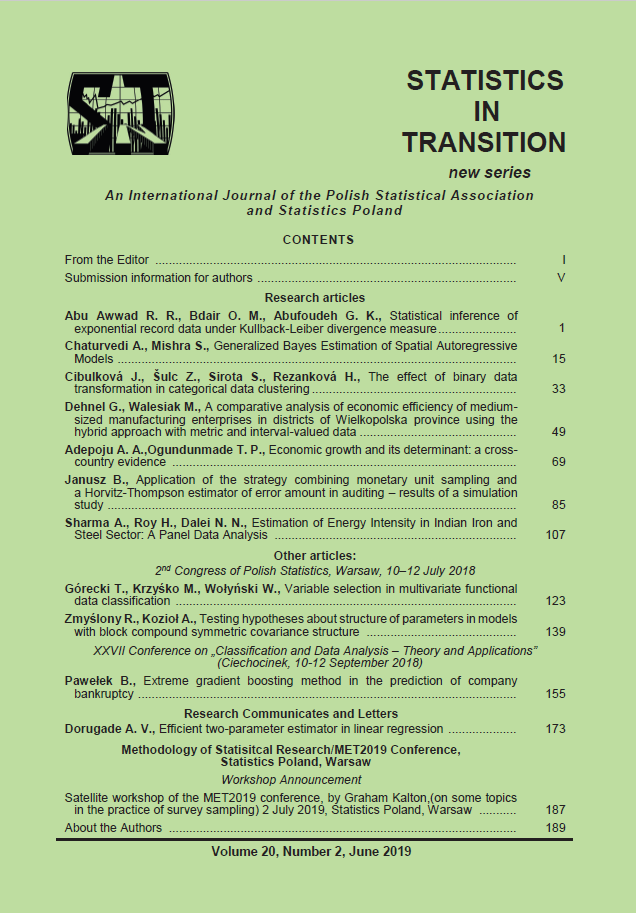ARTICLE
ABSTRACT
Empirical evidence from a panel of 126 countries, over the time period of 2010 to 2014, indicates that economic growth is dependent on various factors. This paper finds that government expenditure control, reduced inflation and increased trade openness are the factors that boost the economic growth of a country. Significant evidence is seen for government consumption, fiscal policy and trade openness. No significant relationship has been observed between exchange rate and economic growth, whereas unemployment influences output for African countries. The cross regional analysis of Asian, European, African, Caribbean, and American countries gives specific determinants for these regions. Economic growth is also analysed in developing, developed, least developed, Muslim and petroleum exporting and emerging countries.
The results of this study validate the dependence of economic growth on various factors. Fiscal balance has shown a consistent positive relationship with economic growth throughout the analyses. Fiscal balance and unemployment rate played their role in the growth of African countries. Inflation rates and increased openness were significant for some regions. Exchange rate did not return significant coefficients for any of the sub-regions. Government consumption, trade openness, policy interest rate and industrial production rate showed significant effect for different regions of the world.
KEYWORDS
economic growth, panel data analysis, growth determinants
REFERENCES
ACHEN, C. H., (2000). Why Lagged Dependent Variables can Suppress the Explanatory Power of other Independent Variables, Paper presented at the annual meeting of the Political Methodology Section of the American Political Science Association, Los Angeles, CA, July 20–22.
ASCHAUER, D. A., (1990). Is Government Spending Stimulative?, Contemporary Economic Policy, 8 (4), pp. 30–46.
AZARIADIS, C., LAHIRI, A., (1997). Do Rich Countries Choose Better Governments?, Working paper, Department of Economics, UCLA.
BARRO, R. J., (1990). Government Spending in a Simple Model of Endogenous Growth, Journal of Political Economy, 98, pp. 103–125.
BARRO, R. J., (1995). Inflation and Economic Growth, Bank of England Economic Bulletin 35, pp. 1–11.
BARRO, R. J., (1996a). Democracy and Growth, Journal of Economic Growth 1, pp. 1–27.
BARRO, R. J., (1996b). Determinants of Economic Growth: A Cross-Country Empirical Study, NBER Working Paper, No. 5698, Cambridge, Mass.: National Bureau of Economic Research.
BARRO, R. J., (1997). Determinants of Economic Growth: A Cross-Country Empirical Study, Cambridge, MA: MIT Press.
BENHABIB, J., SPIEGEL, M. S., (1994). The Role of Human Capital in Economic Development: Evidence from Aggregate Cross-Country Data, Journal of Monetary Economics, 34, pp. 143–173.
BRUMM, H. J., (1997). Military Spending, Government Disarray, and Economic Growth: A Cross-Country Empirical Analysis, Journal of Macroeconomics, 19, pp. 827–838.
CHOWDHURY, A. R., (1991). A Causal Analysis of Defense Spending and Economic Growth, Journal of Conflict Resolution, 35, pp. 80–97.
COZIER, B., SELODY, J., (1992). Inflation and Macroeconomic Performance: Some Cross-Country Evidence, Working Paper, No. 92–06, Ottawa: Bank of Canada, Department of Monetary and Financial Analysis.
DEVARAJAN, S., SWAROOP, V., ZOU, H-F., (1996). The Composition of Public Expenditure and Economic Growth, Journal of Monetary Economics, 37, pp. 313–344.
DRURY, A. C, KRIECKHAUS, J., LUSZTIG, M., (2006). Corruption, Democracy and Economic Growth, International Political Science Review, 27 (2), pp. 121–136.
HARRISON, A., (1996). Openness and Growth: A Time Series, Cross-Country Analysis for Developing Countries, Journal of Development Economics, 48, pp. 419–447.
HSIEH, E., LAI, K. S., (1994). Government Spending and Economic Growth: The G-7 Experience, Applied Economics, 26, pp. 535–542.
KAUFMANN, D., AART, K., MASTRUZZI, M., (2003). Governance Matters III: Governance Indicators for 1996–2002, World Bank Policy Research Working Paper, No. 3106, Washington, D.C.
KIM, H., (1996). Trade-offs between Military Spending, Quality of Life and Economic Growth, Comparative Economic Studies, 38, pp. 69–84.
KLEIN, T., (2004). Military Expenditure and Economic Growth: Peru 1970–1996, Journal of Defense and Peace Economics, 15, pp. 275–287.
KORMENDI, R. C., MEGUIRE, P. G., (1985). Macroeconomic Determinants of Growth: Cross-Country Evidence, Journal of Monetary Economics, 16 (2), pp. 141–163.
LIM, D., (1983). Another Look at Growth and Defense in Less Developed Countries, Economic Development and Cultural Change, 31, pp. 377–384.
LIPSET, S. M., (1959). Some Social Requisites of Democracy, American Political Science Review, 53, pp. 69–105.
LIPSET, S. M., (1960). Political Man: The Social Bases of Politics, New York: Doubleday.
MATSUYAMA, K., (1992). Agricultural Productivity, Comparative Advantage and Economic Growth, Journal of Economic Theory, 58 (2), pp. 317–334.
MAURO, P., (1995). Corruption and Growth, Quarterly Journal of Economics, 110, pp. 681–712.
SACHS, J. D., (2001). Tropical Underdevelopment, NBER Working Paper, No. W8119.
SACHS, J. D., WARNER, A. M., (1995). Natural Resource Abundance and Economic Growth, NBER Working Paper, No. W5398.
SACHS, J. D., WARNER, A. M., (1997). Sources of Slow Growth in African Economies, Journal of African Economies, 6, pp. 335–376.
YANIKKAYA, H., (2003). Trade Openness and Economic Growth: A Cross-Country Empirical Investigation, Journal of Development Economics, 72, pp. 57–89.
